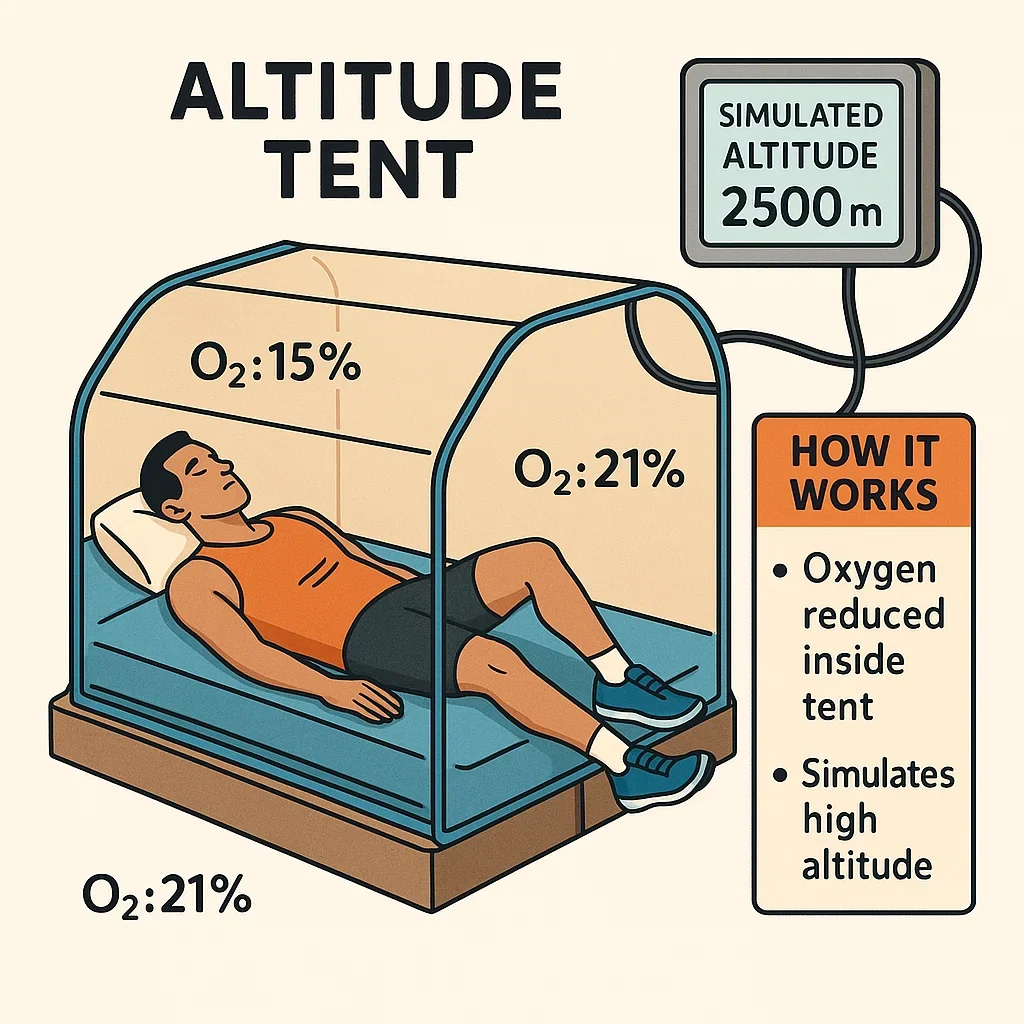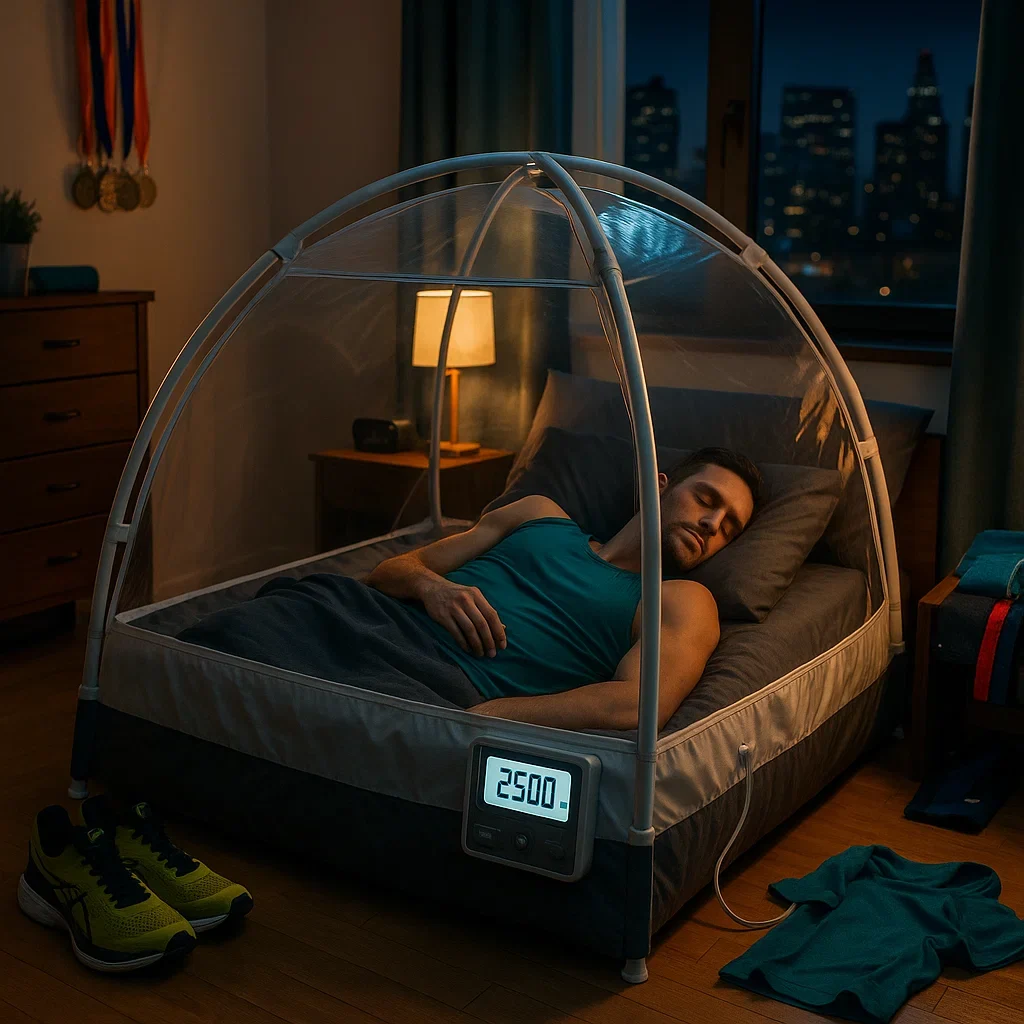Altitude Tent Training for Ultrarunners: Science, Benefits & Pitfalls
Wish you could live in the mountains, but stuck at sea level? Welcome to the world of altitude tent training—the ultimate “sleep high, train low” hack for ultrarunners. But does it really deliver mountain gains, or is it just an expensive gimmick? Let’s break down the science, benefits, protocols, and pitfalls—Lost Pace style.
🏕️ What Is Altitude Tent Training?
Altitude tent training means sleeping inside a sealed tent or canopy with reduced oxygen (O₂) pumped in via a generator. It simulates being at 2,000–3,000 meters above sea level—even if your real altitude is zero. Your body adapts by making more red blood cells, boosting oxygen delivery, and prepping you for mountain ultras.
- Sleep high, train low: You rest at “altitude” overnight, but do your hardest workouts at normal O₂ for better quality and recovery.
- Portable & flexible: Modern tents fit any bed, from student apartment to home gym.
- Science-driven: Used by Olympic athletes since the 1990s, but now more accessible to all.
🧪 How Does It Work?
- Oxygen reduced: The tent’s generator lowers FiO₂ (fraction of inspired oxygen) from 21% (normal air) to 15–16% (2,500–3,000m equivalent).
- Overnight exposure: 6–9 hours per night for at least 2–4 weeks is the sweet spot for measurable gains.
- Key adaptation: Your kidneys release EPO (erythropoietin), stimulating more red blood cells—if, and only if, your iron stores are adequate.
- Stacking effect: Night after night, your body “remembers” the low oxygen, driving longer-term adaptations even as you train hard by day.
🔬 Who Actually Benefits From Tent Training?
Best for:
- Ultrarunners with little or no access to real mountains
- Racers preparing for events above 2,000m
- Time-crunched athletes who can’t travel for long training camps
- Anyone who wants to combine hard training (at low altitude) with “sleeping high”
- Runners with iron deficiency or anemia (always check ferritin!)
- People who can’t commit to 2+ weeks of nightly tent use
- Those expecting “miracle” gains after only a few nights
💡 Quick Pros & Cons
- Pros: Proven science, flexible for busy lives, boosts adaptation without sacrificing workout intensity.
- Cons: Costly equipment, needs commitment, may disturb sleep quality in some, not for those with untreated anemia or respiratory issues.
📅 Best Protocols: How to Use Your Altitude Tent for Real Gains
Ready to get the most from your altitude tent? Here’s a science-based approach used by elite coaches and verified in real-world studies. Consistency is king!
- Target “altitude”: Start at 2,000m simulated (FiO₂ ~17%) and ramp up to 2,500–3,000m (FiO₂ ~15–16%) over 5–7 nights.
- Exposure time: Minimum 6–8 hours per night, aiming for 14–28 consecutive nights. More is better, but avoid sleep deprivation!
- Sleep quality matters: If sleep is very disturbed, drop the altitude a notch—broken sleep blunts adaptation.
- Combine with iron: Ensure ferritin >40–50 ng/mL before and during the tent phase, or the adaptation will stall.
- Don’t skip hard workouts: Maintain normal, high-quality interval and long runs outside the tent. “Train low” ensures your speed and strength don’t fade.
- Monitor SpO₂: Use a pulse oximeter for a morning check—adaptation = trending back toward your normal values over days/weeks.
⚠️ Troubleshooting & Common Pitfalls
- Poor sleep: Lower the simulated altitude or improve airflow (fans, fresh sheets). Never “force” high altitude at the expense of sleep!
- No performance gain: Check iron status, tent hours, and device calibration. Remember, “garbage in, garbage out”.
- Feeling ill or fatigued: Take a break. Tent adaptation is a stress—if combined with hard training, life stress, or illness, rest is your friend.
- Overheating: Tents can get warm. Use light sleepwear and ventilate before bed.
- Disrupted relationships: Let your household know about the noise! Communication is adaptation, too.
❓ Altitude Tent FAQ
💤 How many weeks of tent use do I need before my race?
🔢 What’s the ideal “altitude” setting for most runners?
🩸 Do I have to take iron supplements during tent training?
🌡️ Will my resting SpO₂ drop a lot?
😴 What if I can’t sleep in the tent?
💪 Can I use the tent for naps instead of overnight?
🛌 Does altitude tent training help sea-level races?
🔊 Is the generator noisy?
🧬 Can anyone use an altitude tent?
⏱️ Should I stop using the tent before my race?
🏁 Summary & Lost Pace Final Thoughts
Altitude tent training isn’t just a pro gimmick—it’s a science-backed tool for real adaptation, now available to everyday ultrarunners. With the right protocol, iron sufficiency, and consistent use, you can show up at your next mountain ultra ready for the real thing. Just remember: technology is powerful, but only if you combine it with smart training, self-care, and listening to your body.


About the Author
Lost Pace is an ultramarathon runner, shoe-tester and the founder of umit.net. Based year-round in Türkiye’s rugged Kaçkar Mountains, he has logged 10,000 + km of technical trail running and completed multiple 50 K–100 K ultras.
Blending mountain grit with data, Lost analyses power (CP 300 W), HRV and nutrition to craft evidence-backed training plans. He has co-written 260 + long-form guides on footwear science, recovery and endurance nutrition, and is a regular beta-tester of AI-driven coaching tools.
When he isn’t chasing PRs or testing midsoles, you’ll find him sharing peer-reviewed research in plain English to help runners train smarter, stay healthier and finish stronger.
Ultrarunner · Data geek · Vegan athlete

